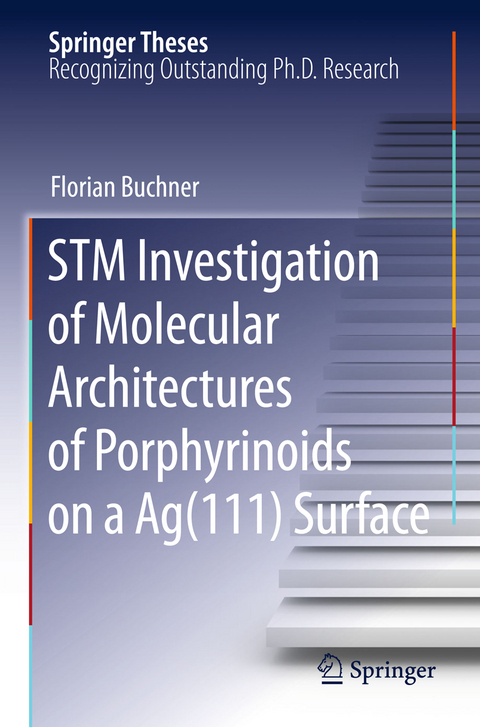
STM Investigation of Molecular Architectures of Porphyrinoids on a Ag(111) Surface
Springer Berlin (Verlag)
978-3-642-26595-2 (ISBN)
The functionalization of surfaces on the nanoscale is one of the most fascinating and at the same time challenging topics in science. It is the key to tailoring catalysts, sensors, or devices for solar energy conversion, whose functional principle is based on the interaction of an active solid surface with another (liquid or gaseous) phase. As an example, planar transition metal complexes adsorbed on solid supports are promising candidates for novel heterogeneous catalysts. An important feature of these catalysts, compared to supported metal clusters, is the fact that the active sites, i. e. , the coordinated metal centers with their vacant axial coordination sites, are well de?ned and uniform. Metalloporphyrinoids are particularly suitable in this respect because they combine a structure forming element-the rigid molecular frame, which often induces long range order-with an active site, the coordinated metal ion. Its planar coordination environment leaves two axial coordination sites available for additional ligands. If adsorbed on a surface, one of these axial sites is occupied by the underlying substrate. The resulting electronic interaction with the surface can be used to tailor the electronic structure and thereby the reactivity of the metal center. The remaining site is free for the attachment of molecules (sensor functionality) and/or operates as a reaction center (single-site catalysis). Prototype examples are omnipresent in nature, where in particular metallo-tetrapyrrols play a decisive role in important biological processes, with the most prominent examples being iron porphyrins in heme, magnesium porphyrins in chlorophyll, and cobalt corrin in vitamin B12.
Results.- Self-Assembly and Individual Appearance of Tetraphenylporphyrins on Ag(111).- Self-Assembly and Individual Appearance of Cobalt(II)-Tetrakisditertbutylphenylporphyrins on Ag(111).- Coordination of Iron and Cobalt Atoms by Tetraphenylporphyrin Monolayers on Ag(111) and Formation of Metal(II)-Tetraphenylporphyrin.- Different Aspects of 2H-Tetrakis-di-tert-butylphenylporphyrin on Ag(111).- Direct Metalation of a Phthalocyanine Monolayer on Ag(111) with Co-adsorbed Iron Atoms.- Multicomponent Adlayers of Tetraphenylporphyrins on Ag(111).- Modification of the Growth of Iron on Ag(111) by Predeposited Organic Monolayers.- Geometric and Electronic Aspects of CoTPP upon Dosage of NO.- Self-Assembly and Voltage-Dependent Appearance of Octaethylporphyrins.- Summary and Outlook.- Fundamentals.- Experimental Setup.
| Erscheint lt. Verlag | 2.1.2013 |
|---|---|
| Reihe/Serie | Springer Theses |
| Zusatzinfo | XXVII, 164 p. |
| Verlagsort | Berlin |
| Sprache | englisch |
| Maße | 155 x 235 mm |
| Gewicht | 298 g |
| Themenwelt | Naturwissenschaften ► Chemie ► Physikalische Chemie |
| Schlagworte | Electronics • iron and cobalt coordination • molecular adsorbates • Molecular architectures • organic monolayers • Porphyrinoids • Scanning Tunneling Microscopy • scanning tunneling spectroscopy • Self-Assembly • stem • STM • Supra • supramolecular chemistry • Surface Chemistry • UHV System • vapour deposition |
| ISBN-10 | 3-642-26595-2 / 3642265952 |
| ISBN-13 | 978-3-642-26595-2 / 9783642265952 |
| Zustand | Neuware |
| Haben Sie eine Frage zum Produkt? |
aus dem Bereich


